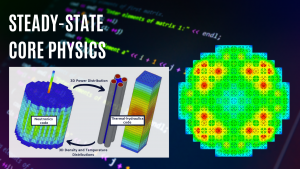During the first year of the project the partners have been busy working to analyse, investigate, and create the different elements needed to launch the innovative teaching courses. Read the details from each work package (WP) below to see exactly what the GRE@T-PIONEeR alliance has been up to!

Work Package 1: Mapping of the stakeholder needs versus course offering and teaching methods has for primary target to align the objectives of the project with the stakeholder needs, both in terms of the technical content of the teaching materials and in terms of the pedagogy used for teaching the corresponding courses. For that purpose, a mapping of the competences in the nuclear sector was carried out, together with an assessment of the future needs and skills requirements, following the nuclear job taxonomy classification. Four areas were identified as critical for securing long-term competences: reactor physics, new techniques (Small Modular Reactors – SMRs, Generation-IV reactors and fusion technologies), nuclear operations, and decommissioning.
Based on this mapping analysis, an inventory of the existing training offers in the four identified areas was completed. 77 programs/courses across Europe, the Middle-East, Russia and the USA were evaluated along various skills. Moreover, the pedagogical methods used in those curricula were scrutinised. The purpose was to identify good examples to increase the efficacy of teaching/learning. The use of advanced educational techniques in nuclear science and engineering, as well as in other sectors, was benchmarked. Interviews with four teachers using innovative pedagogical methods were carried out. The outcomes of the above activities were presented at a collaborative workshop which took place November 18th, 2021 in Brussels, right after the NESTet 2021 conference. The workshop also included group activities to discuss the use of innovative teaching methods. Although the basic pedagogical set-up to be followed by the GRE@T-PIONEeR project has already been established, the recommendations made for program adaptations and the outcome of the workshop will be used for the design of the hands-on sessions developed as part of the GRE@T-PIONEeR education.

The goal of Work Package 2: Development of a course package on nuclear data for energy and nonenergy applications is the development of a course package on nuclear cross-sections for neutron transport. For that purpose, WP2 has been working to define the content and exercises for a better understanding of the nuclear data pipeline processes. It covers all steps starting from the measurements of the cross-sections to their validation and final use in nuclear reactor calculations. Examples on the important role of nuclear data for calculations of nuclear reactor systems have been defined, as well.
From an experimental point of view, WP2 has been working in the definition of a set of experiments for direct application to cross-sections measurements. These experiments will be performed in three different research reactors of the project:
- The AKR-2 at the Technical University Dresden using activation analysis experiments for a set of irradiated gold foils, neutron transmission measurements and pile oscillator experiments.
- The CROCUS reactor at the École Polytechnique Fédérale de Lausanne with gold foil activation measurements and reactivity worth of samples using pile-oscillation techniques.
- The BME Training Reactor at the Budapest University of Technology and Economics having activation analysis experiments and measurement of the Doppler effect.
During this first year, an initial End User group for WP2 has been created. The Institut de Radioprotection et de Sûreté Nucléaire (IRSN) will be participating in the process of generation and evaluation of nuclear data libraries, and the Nuclear Energy Agency (NEA) will also be participating trough the processing of nuclear data libraries and the assessment of nuclear data uncertainties thanks to their web applications such as JANIS, DICE and NDaST.

Work Package 3: Development of a course package on neutron transport at the fuel cell and assembly levels is focused on the development of a course package on steady-state neutron transport at the fuel cell and assembly levels.
During the first year of the project, the work has been mainly focused on the development of a handbook on this topic (Task 3.1), whose contents have been agreed among the task partners (PoliTo, Chalmers and BME). A first draft has been circulated during September and the revision of the document is currently under way.
Additional work on the development of hands-on exercises (Task 3.2) has been carried out, reaching an agreement among partners involved (Chalmers, TUD, EPFL and BME) on the topics to be covered and the timing of the experimental activities in the facilities available to the consortium. The further detailing of these activities is part of the objectives of the next 6 months of the project.

Work Package 4: Development of a course package on core modelling for core design aims at developing a set of educational materials concerning modelling of nuclear reactors at the core level in steady-state conditions: conditions expected regularly during the operation, refuelling or maintenance of a reactor.
Modelling of the steady-state neutron transport in nuclear reactors at the core level allows engineers to characterise core behaviour and it is therefore essential for the design and operation of present and future system technologies (e.g., Small Modular Reactors or Gen-IV systems). Consequently, a thorough understanding of the simulation at the core level is crucial in diverse sectors of nuclear industry.
The main outcomes of the Work Package will be presented in two handbooks, two sets of hand-on training exercises and two sets of video lectures.
The first handbook outlines the methods that can be used for steady-state core calculations (deterministic and Monte Carlo approaches) highlighting the pros and cons of each method and its applicability. The second handbook is intended to illustrate the principles for core design and operation in steady-state conditions of Pressurized Water Reactors and Boiling Water Reactors, which represent 82% of the reactors in operation in the world nowadays.
Hand-on training exercises will be developed to show the link between methods, their implementation in computer codes and the intended core results. In addition, measurements at research reactors will be carried out to illustrate experimental techniques and allow comparison of experimental and calculation approaches (both deterministic and Monte Carlo).
During the first year of the project, drafts of the handbooks have been developed, and the contents of the hand-on exercises have been established with the final goal of empowering trainees and improve their knowledge and technical skills concerning simulation at the core level.

Work Package 5: Development of a course package on core modelling for transients. The main focus of this WP is on transient simulations requiring the coupling of the different physics involved and their interaction: neutron transport, heat transfer, fluid dynamics, and possibly fuel thermo-mechanics. This WP thus aims at developing course materials (handbooks and hands-on exercises) giving the future students a comprehensive overview of the deterministic methods for non-steady-state conditions, their approximations, and their range of validity for core calculations.
The contents of the handbooks outline the generation of nuclear parameters for transient calculations, general space and time discretization for the multigroup diffusion equation, as well as practical applications in neutronic codes (like neutron flux fluctuations), and coupling to thermal-hydraulics. Reduced Order Modelling and Factorization Techniques and macroscopic nuclear thermal-hydraulic modelling are part of the actions for this WP too. A practical approach for macroscopic thermo-mechanical modelling with the open-source code package OpenFOAM will be used.
Hands-on training exercises have also been developed using models for two different reactors (BWR and PWR). The exercises will make use of the state-of-the-art computer codes in this field and will be combined with measurements at research reactors to demonstrate the most important phenomena and to illustrate the use of the calculation methods. Research reactor experiments will also be used to demonstrate practical applications and their limitations at the CROCUS reactor, at the AKR-2, and at the BME Training Reactor. Careful attention will be paid to the development of hands-on training exercises that can be used in hybrid learning environments that combine both on-site and off-site attendees.
This WP is in close relation with WP4 and WP6, sharing most of the reactor models (steady state and transient scenarios), using the same computer codes for their analysis.
During the first year of the project, drafts of the handbooks have been developed, and the contents of the hand-on exercises have been established with the final goal of empowering trainees and improve their knowledge and technical skills concerning simulation at the core level.

Work Package 6: Development of a course package on reactor transients, nuclear safety and uncertainty and sensitivity analysis
The activities in WP6 have been focused on the preparation of the handbook for the course on Safety Analysis and Uncertainty and Sensitivity Analysis methodology. The structure of the handbook offers an introduction to the ideas behind nuclear safety with an explanation of the most relevant types of accidents expected in LWRs (Light Water Reactors). The uncertainty and sensitivity analysis section is introduced with the fundamental statistical concepts needed to understand the methodologies, followed by an explanation of the practical steps: the gathering of uncertainty information, sampling procedures, code executions, and statistical treatment of the output uncertainty information. An overview of two of the most frequently used state-of-the-art system analysis codes ATHLET and TRACE-PARCS is also included with an explanation of the two main scenarios that will be used in the practical exercises. In addition to the handbook, the practical exercises have also been defined and work has started in the preparation of the classes.

Work Package 7: Development of a course package on radiation protection in a nuclear environment. Radiation protection is a crucial part of the operation of a nuclear installation and a specific interdisciplinary field requiring knowledge of reactor physics, neutron transport calculations, shielding design, instrumentation, health physics, and radiation protection standards and regulations.
The WP aims to modernise the radiation protection briefing obligatory for any student or trainee entering a nuclear installation, like the participating research reactors where the laboratory exercises will be performed. Furthermore, this WP couples radiation protection and health physics with the neutronics calculation tools and methods touched upon in WP3 and 4 and presents the specificities of shielding and dose rate calculations. The course material developed covers:
- The principles of health physics and radiation protection regulation.
- The instrumentation for radiation protection in nuclear installations.
- The shielding calculation methods (deterministic and Monte Carlo), neutron and gamma transport, and deep penetration problems.
Hands-on exercises will involve tools to design and evaluate biological protection of reactors from the simplest approximations to sophisticated Monte Carlo and deterministic models. In combination with these exercises, research reactor laboratory exercises will aim to familiarise the students with the radiation protection instrumentation, practice in nuclear installations, measure shielding material properties, and perform measurements for some of the calculated shielding problems.

Work Package 8: Promotion, dissemination and courses teaching is focused on communicating about the project, disseminating the results and will involve teaching the courses towards the end of the project.
Over the first year of the project, communication materials were created and actions were implemented in order to support GRE@T-PIONEeR’s activites. A Communication and Dissemination plan was created to outline the tools, actions, and materials to be used in project communication and dissemination efforts. Some communication materials created for the project include:
- Project visual identity and logo;
- A project launch press release;
- Social media accounts: Twitter and LinkedIn;
- The project website and accompanying deliverable;
- A brochure and roll-up;
- A Zenodo page to host publications;
- The first project newsletter.
As these actions are continuous throughout the project, keep up to date by following us on social media and keeping an eye on the website!




